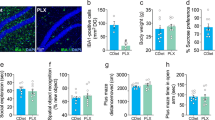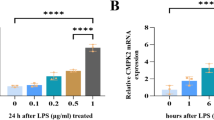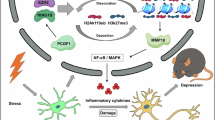Abstract
Depression is a chronic mental illness that has emerged as the second most prevalent disease globally, characterized by symptoms such as low mood, reduced interest, and cognitive impairment. The onset of depression has been associated with microglial inflammation, but the molecular mechanisms behind this are not well understood. Here, we investigated the mechanisms involved in the roles of microglial inflammation in promoting depression by establishing a mouse model of inflammation-related depression via lipopolysaccharide (LPS) administration. We found that LPS treatment led to microglial activation and increased the deubiquitinating enzyme, USP22, expression in the mouse hippocampus. Further, knockdown of USP22 in microglia inhibited depressive-like behaviors and intracerebral inflammation in the mouse model. Moreover, subsequent mechanistic analyses revealed that KAT2A, which serves as a ubiquitination substrate, is modulated by USP22, thereby influencing mitochondrial damage and oxidative stress in microglia. Our findings indicate that USP22 facilitates oxidative stress and inflammatory responses in microglia through the deubiquitination of KAT2A, providing a promising target for the development of therapeutic strategy for the depression treatment.
This is a preview of subscription content, access via your institution
Access options
Subscribe to this journal
Receive 13 print issues and online access
$259.00 per year
only $19.92 per issue
Buy this article
- Purchase on SpringerLink
- Instant access to full article PDF
Prices may be subject to local taxes which are calculated during checkout





Similar content being viewed by others
Data availability
All data generated or analysed during this study are included in this manuscript and supplementary material.
References
G B D Diseases and C Injuries. Global burden of 369 diseases and injuries in 204 countries and territories, 1990-2019: a systematic analysis for the Global Burden of Disease Study 2019. Lancet. 2020;396:1204–22.
Reynolds RH, Wagen AZ, Lona-Durazo F, Scholz SW, Shoai M, Hardy J, et al. Local genetic correlations exist among neurodegenerative and neuropsychiatric diseases. NPJ Parkinsons Dis. 2023;9:70.
Monroe SM, Harkness KL. Major depression and its recurrences: life course matters. Annu Rev Clin Psychol. 2022;18:329–57.
Zhao F, Guan W. Defects of parvalbumin-positive interneurons are implicated in psychiatric disorders. Biochem Pharmacol. 2024;230:116599.
Sampogna G, Toni C, Catapano P, Rocca BD, Di Vincenzo M, Luciano M, et al. New trends in personalized treatment of depression. Curr Opin Psychiatry. 2024;37:3–8.
Kennis M, Gerritsen L, Van Dalen M, Williams A, Cuijpers P, Bockting C. Prospective biomarkers of major depressive disorder: a systematic review and meta-analysis. Mol Psychiatry. 2020;25:321–38.
Martinez B, Peplow PV. Misdiagnoses of psychiatric disorders and the utility of diagnostic microRNA biomarkers. NeuroMarkers. 2024;1:100002.
Martinez B, Peplow PV. MicroRNAs as potential biomarkers for diagnosis of major depressive disorder and influence of antidepressant treatment. NeuroMarkers. 2024;1:100001.
Borbely E, Simon M, Fuchs E, Wiborg O, Czeh B, Helyes Z. Novel drug developmental strategies for treatment-resistant depression. Br J Pharmacol. 2022;179:1146–86.
Brown JVE, Wilson CA, Ayre K, Robertson L, South E, Molyneaux E, et al. Antidepressant treatment for postnatal depression. Cochrane Database Syst Rev. 2021;2:CD013560.
Moncomble L, Neveu P, Raimond C, Guérout N. Magnetic stimulation techniques for the treatment of central nervous system lesions: a narrative review. Adv Technol Neurosci. 2025;1:34–46.
Wu ZH, Fan H, Gao SY, Jin YF, Cheng C, Jiang B, et al. Antidepressant-like activity of oroxylin A in mice models of depression: A behavioral and neurobiological characterization. Front Pharmacol. 2022;13:921553.
Beurel E, Toups M, Nemeroff CB. The bidirectional relationship of depression and inflammation: double trouble. Neuron. 2020;107:234–56.
Bai Y, Chang D, Ren H, Ju M, Wang Y, Chen B, et al. Engagement of N(6)-methyladenisine methylation of Gng4 mRNA in astrocyte dysfunction regulated by CircHECW2. Acta Pharm Sin B. 2024;14:1644–60.
Qi W, Jin X, Guan W. Purinergic P2X7 receptor as a potential therapeutic target in depression. Biochem Pharmacol. 2024;219:115959.
Ren J, Zhang Y, Pan H, Shi R, Zhu H, Yang R, et al. Mobilization of the innate immune response by a specific immunostimulant beta-glucan confers resistance to chronic stress-induced depression-like behavior by preventing neuroinflammatory responses. Int Immunopharmacol. 2024;127:111405.
Bai S, Guo W, Feng Y, Deng H, Li G, Nie H, et al. Efficacy and safety of anti-inflammatory agents for the treatment of major depressive disorder: a systematic review and meta-analysis of randomised controlled trials. J Neurol Neurosurg Psychiatry. 2020;91:21–32.
Lu Z, Liu Z, Wang C, Jiang R, Wang Z, Liao W, et al. CD300LF(+) microglia impede the neuroinflammation following traumatic brain injury by inhibiting STING pathway. CNS Neurosci Ther. 2024;30:e14824.
Ruan Q, Geng Y, Zhao M, Zhang H, Cheng X, Zhao T, et al. Prolyl hydroxylase inhibitor FG-4592 alleviates neuroinflammation via HIF-1/BNIP3 signaling in microglia. Biomed Pharmacother. 2024;173:116342.
Kokkosis AG, Madeira MM, Hage Z, Valais K, Koliatsis D, Resutov E, et al. Chronic psychosocial stress triggers microglial-/macrophage-induced inflammatory responses leading to neuronal dysfunction and depressive-related behavior. Glia. 2024;72:111–32.
Chen B, Zhao C, Zhu H, Lu X, Liu H, Lu Q, et al. beta-glucan, a specific immuno-stimulant, produces rapid antidepressant effects by stimulating ERK1/2-dependent synthesis of BDNF in the hippocampus. Eur J Pharmacol. 2023;961:176161.
Enache D, Pariante CM, Mondelli V. Markers of central inflammation in major depressive disorder: A systematic review and meta-analysis of studies examining cerebrospinal fluid, positron emission tomography and post-mortem brain tissue. Brain Behav Immun. 2019;81:24–40.
Yu X, Ye L, Liang H, Li H, Gao S, Xu C, et al. The alterations in CD4(+)Treg cells across various phases of major depression. J Affect Disord. 2024;362:485–92.
Zhang Y, Du L, Bai Y, Han B, He C, Gong L, et al. CircDYM ameliorates depressive-like behavior by targeting miR-9 to regulate microglial activation via HSP90 ubiquitination. Mol Psychiatry. 2020;25:1175–90.
Han X, Sun S, Sun Y, Song Q, Zhu J, Song N, et al. Small molecule-driven NLRP3 inflammation inhibition via interplay between ubiquitination and autophagy: implications for Parkinson disease. Autophagy. 2019;15:1860–81.
Huang X, Tan J, Ji Y, Luo J, Zhao Y, Zhao J. BRCC3 mediates inflammation and pyroptosis in cerebral ischemia/reperfusion injury by activating the NLRP6 inflammasome. CNS Neurosci Ther. 2024;30:e14697.
Di Q, Zhao X, Tang H, Li X, Xiao Y, Wu H, et al. USP22 suppresses the NLRP3 inflammasome by degrading NLRP3 via ATG5-dependent autophagy. Autophagy. 2023;19:873–85.
Dietlein N, Wang X, Metz J, Disson O, Shang F, Beyersdorffer C, et al. Usp22 is an intracellular regulator of systemic emergency hematopoiesis. Sci Immunol. 2022;7:eabq2061.
Tang Y, Wang T, Gu L, Xu Y, Yang Z, Zhu W, et al. USP11 Exacerbates Radiation-Induced Pneumonitis by Activating Endothelial Cell Inflammatory Response via OTUD5-STING Signaling. Int J Radiat Oncol Biol Phys. 2024;119:1261–74.
Pan Z, Yu X, Wang W, Shen K, Chen J, Zhang Y, et al. Sestrin2 remedies neuroinflammatory response by inhibiting A1 astrocyte conversion via autophagy. J Neurochem. 2024;9:2640–53.
Ali T, Rahman SU, Hao Q, Li W, Liu Z, Ali Shah F, et al. Melatonin prevents neuroinflammation and relieves depression by attenuating autophagy impairment through FOXO3a regulation. J Pineal Res. 2020;69:e12667.
Rey R, Chauvet-Gelinier JC, Suaud-Chagny MF, Ragot S, Bonin B, D’amato T, et al. Distinct Expression Pattern of Epigenetic Machinery Genes in Blood Leucocytes and Brain Cortex of Depressive Patients. Mol Neurobiol. 2019;56:4697–707.
Nguyen MU, Iqbal J, Potgieter S, Huang W, Pfeffer J, Woo S, et al. KAT2A and KAT2B prevent double-stranded RNA accumulation and interferon signaling to maintain intestinal stem cell renewal. Sci Adv. 2024;10:eadl1584.
Liu Y, Zeng JM, Zhao H, Ao CY, Ao LH, Ban JQ, et al. Mechanism of KAT2A regulation of H3K36ac in manganese-induced oxidative damage to mitochondria in the nervous system and intervention by curcumin. Ecotoxicol Environ Saf. 2024;273:116155.
Zhu XX, Zheng GL, Lu QB, Su JB, Liu Y, Wang M, et al. Cichoric acid ameliorates sepsis-induced acute kidney injury by inhibiting M1 macrophage polarization. Eur J Pharmacol. 2024;976:176696.
He MC, Shi Z, Sha NN, Chen N, Peng SY, Liao DF, et al. Paricalcitol alleviates lipopolysaccharide-induced depressive-like behavior by suppressing hypothalamic microglia activation and neuroinflammation. Biochem Pharmacol. 2019;163:1–8.
Wang B, Huang X, Pan X, Zhang T, Hou C, Su WJ, et al. Minocycline prevents the depressive-like behavior through inhibiting the release of HMGB1 from microglia and neurons. Brain Behav Immun. 2020;88:132–43.
Fang Y, Ding X, Zhang Y, Cai L, Ge Y, Ma K, et al. Fluoxetine inhibited the activation of A1 reactive astrocyte in a mouse model of major depressive disorder through astrocytic 5-HT(2B)R/beta-arrestin2 pathway. J Neuroinflammation. 2022;19:23.
Jia X, Gao Z, Hu H. Microglia in depression: current perspectives. Sci China Life Sci. 2021;64:911–25.
Chen L, Zeng L, Li W, Li JS. The activation of hippocampal microglial cells and their role in the regulation of pain. J Integr Neurosci. 2025;24:27730.
Kosinsky RL, Saul D, Ammer-Herrmenau C, Faubion WA, Neesse A, Johnsen SA. USP22 Suppresses SPARC Expression in Acute Colitis and Inflammation-Associated Colorectal Cancer. Cancers (Basel). 2021;13:1817.
Yan R, Chu J, Zhou Y, Shan W, Hu Y, Lin M, et al. Ubiquitin-specific protease 22 ameliorates chronic alcohol-associated liver disease by regulating BRD4. Pharmacol Res. 2021;168:105594.
Shi JX, Wang QJ, Li H, Huang Q. Silencing of USP22 suppresses high glucose-induced apoptosis, ROS production and inflammation in podocytes. Mol Biosyst. 2016;12:1445–56.
Yu MC, Li XL, Ning ML, Yan ZZ, Yu WT. USP22 inhibits microglial M1 polarization by regulating the PU.1/NLRP3 inflammasome pathway. Brain Res Bull. 2025;220:111157.
Sun HJ, Zheng GL, Wang ZC, Liu Y, Bao N, Xiao PX, et al. Chicoric acid ameliorates sepsis-induced cardiomyopathy via regulating macrophage metabolism reprogramming. Phytomedicine. 2024;123:155175.
Zhang Y, Gao Y, Ding Y, Jiang Y, Chen H, Zhan Z, et al. Targeting KAT2A inhibits inflammatory macrophage activation and rheumatoid arthritis through epigenetic and metabolic reprogramming. MedComm. 2023;4:e306.
Li H, Li C, Yang LZ, Liu J. Integrative analysis of histone acetyltransferase KAT2A in human cancer. Cancer Biomark. 2023;38:443–63.
Fuhrmann DC, Brune B. Mitochondrial composition and function under the control of hypoxia. Redox Biol. 2017;12:208–15.
Xu HX, Cui SM, Zhang YM, Ren J. Mitochondrial Ca(2+) regulation in the etiology of heart failure: physiological and pathophysiological implications. Acta Pharmacol Sin. 2020;41:1301–9.
Zhao M, Wang Y, Li L, Liu S, Wang C, Yuan Y, et al. Mitochondrial ROS promote mitochondrial dysfunction and inflammation in ischemic acute kidney injury by disrupting TFAM-mediated mtDNA maintenance. Theranostics. 2021;11:1845–63.
Mittal M, Siddiqui MR, Tran K, Reddy SP, Malik AB. Reactive oxygen species in inflammation and tissue injury. Antioxid Redox Signal. 2014;20:1126–67.
Sandiego CM, Gallezot JD, Pittman B, Nabulsi N, Lim K, Lin SF, et al. Imaging robust microglial activation after lipopolysaccharide administration in humans with PET. Proc Natl Acad Sci USA. 2015;112:12468–73.
Funding
This study was supported by the National Natural Science Foundation of China (82301357; 82371278).
Author information
Authors and Affiliations
Contributions
Yan Lu and Rongrong Huang performed the experiments. Yan Lu, Yuhan Zheng, Xiaoru Sun, Yujie Song, Yilu Zhou and Fuyi Shen conducted formal analysis and data curation. Yan Lu and Yuhan Zheng wrote the manuscript. Rongrong Huang and Zhendong Xu administrated this project. All authors have read and agreed to the published version of the paper.
Corresponding authors
Ethics declarations
Competing interests
The authors declare no competing interests.
Additional information
Publisher’s note Springer Nature remains neutral with regard to jurisdictional claims in published maps and institutional affiliations.
Supplementary information
Rights and permissions
Springer Nature or its licensor (e.g. a society or other partner) holds exclusive rights to this article under a publishing agreement with the author(s) or other rightsholder(s); author self-archiving of the accepted manuscript version of this article is solely governed by the terms of such publishing agreement and applicable law.
About this article
Cite this article
Lu, Y., Zheng, Y., Sun, X. et al. Knockdown of USP22 alleviates LPS-induced microglial inflammation and mouse depressive-like behaviors via KAT2A. Neuropsychopharmacol. (2025). https://doi.org/10.1038/s41386-025-02207-y
Received:
Revised:
Accepted:
Published:
DOI: https://doi.org/10.1038/s41386-025-02207-y



